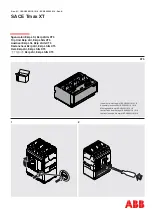
Installation
Testing
High potential tests employ hazardous voltages.
Will cause death or serious injury.
Follow safe procedures, exclude unnecessary personnel and use
safety barriers. Keep away from circuit breaker during application
of test voltages. After test completion, ground both ends and the
middle ring (if visible) of the vacuum interrupter to dissipate any
static charges.
Vacuum interrupters may emit X-ray radiation.
Can result in serious injury.
X-rays can be produced when a high-voltage is placed across two
circuit elements in a vacuum.
Keep personnel more than six feet away from a circuit breaker
under test. All normal metallic doors and panels must be
installed during tests.
Note:
No hazardous X-radiation is
produced with closed contacts, or with
open contacts with rated operating voltage
applied.
Excessive test voltages.
May result in damage to equipment.
Do not perform dielectric tests at test
voltages exceeding the ratings of the tested
equipment.
1. An insulation resistance test is
advisable on the control circuit to
verify that all connections made in the
field are properly insulated.
2. A dielectric test, if possible, should be
made on the high-voltage circuit for
one minute at the voltages
corresponding to the rated voltage of
the equipment. The voltage should be
raised gradually and the circuit under
test should sustain the voltage for one
minute.
22














































